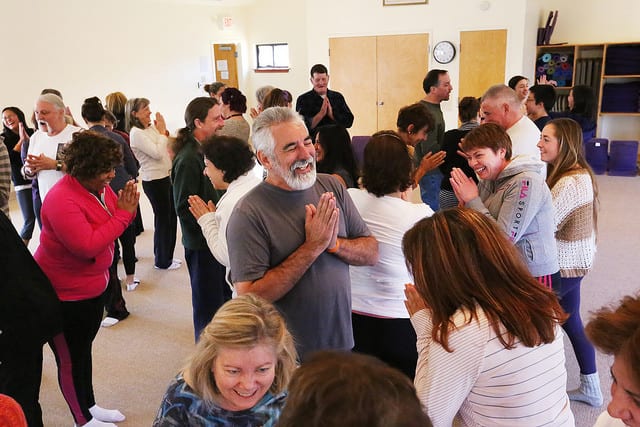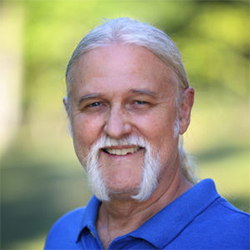
What makes a miracle? We decided to ask Bharata Wingham, a long-time student of A Course in Miracles and an experienced Laugha Yoga Teacher Trainer. In the following interview, Bharata shares his knowledge and understanding of A Course in Miracles, Yoga philosophy, forgiveness, and laughter.
What are all the ways in which A Course in Miracles aligns with Yoga philosophy?
According to Yoga philosophy, the outward forms of the world are maya, or illusion, meaning that they are not real, that is, not Absolute Reality. The world appears to be real; we can say it is “relatively” real. But, to get on in this world of illusion we must act as if it is. One form of Yoga is Jnana Yoga, and a facet of that is Advaita Yoga. Advaita is the philosophy of non-dualism, and the Course also teaches that reality is non-dual.
Yoga also means union, bonding, or coupling. Yoga and the Course both deal a lot with relationships: relationship with others, God, the environment, or whatever we feel separate from or different from. In Yoga, we develop the means to bring the two together. We work to join our unlimited Self with the limited Self—usually we may not feel very connected to God.
Yoga is a broad term. You can classify almost any spiritual teaching that takes us to our true selves as Yoga. So I say the Course is a Christian form of Yoga.
You have mentioned non-dualism, reality, and perception in regards to the Course. What is the role of truth and illusion in A Course in Miracles?
The Course describes truth and illusion as two different levels, you might say. Level 1 is the non-dualistic level of reality in which all is one and God is the only truth. Level 2 is this world; it is the dualistic, illusory world of perception in which we may at times feel separate from everything and everyone and experience ourselves as the individual ego.
You have stated that “The Forgiveness Principle” is a crucial aspect of the path of Yoga and the Course. Can you explain how forgiveness is taught in the Course?
The understanding of truth and illusion (non-dualism and dualism) is what the forgiveness principle is based upon. The Course teaches radical forgiveness. It states that whenever we feel wronged, unjustly treated, or victimized, it is only a misperception. -We feel it is real on this everyday level. –It seems to have really happened at the level of dualism and perception, but the Course teaches you to ask yourself questions about the experience. The Course never asks us to deny the experience we are having, only to examine it closely with the help of our Inner Guide, the Holy Spirit.
At Level One, the ultimate level of oneness, how could anyone harm you? In that level you are not separate. Harm is only possible in a dual state. If I see someone or something as separate from myself, then opposites come into dance-play. -In the dance-play I can harm or help something that is other than myself. Shadows and illusions fight. Truth doesn’t oppose or fight.
God created us in truth as invulnerable and unable to be harmed by anything. Even we cannot hurt ourselves. That’s not to say our body and feelings can’t be hurt–we still seem to live in the dualistic world. But when we forgive and we let go of guilt in ourselves and stop projecting it on others, we see everyone joined as One. Unity enters my awareness. When I remember that, I don’t see someone else as a separate ego—I see that in forgiving them I’m not actually forgiving only them– I’m forgiving myself as well.
So radical forgiveness is looking through that lens of non-dualism and practicing forgiveness, no matter how hard it may be. It is the practice of accepting it, feeling it, looking through it, and experiencing it until duality dissolves and you see truth: in illusion it happened, in reality, it never did.
You are a long-time teacher of Laugha Yoga. Are there any similarities between Laugha Yoga and A Course in Miracles?
The Course got me focused on laughter long before I got involved in laughter Yoga. When I first started with the Course, I noticed there were some direct quotes about laughter. One of the most powerful ones is: “The world will end in laughter.”
What this means is that the world of illusion will end when I can see the humor, the cosmic, karmic joke (karmedy, as I like to call it) of it all. When I can see through the illusion and see to what is really going on, I laugh. Something releases in me that allows me to breathe and relax again; then I am able to fully accept myself and whatever else goes on around me.
When we’re in a non-laughing place, it is because we cannot see through the illusion. There is nothing funny there; there is harm, separateness, and judgment. We can get caught up in chronic seriousness—we must learn to take the ego lightly. The part of us that we identify with is a total abstraction. The Course calls it, “ego;” it’s the “Self” that we think about. It has no reality except the reality that we give to it. If we stop making it up and thinking about it, it disappears. The ego is just an invention of our thoughts.
Thank you for all that you’ve shared, Bharata. What is one thing you would like to leave us with?
Our last freedom is choice. We can choose ego–the world of duality, perception, and illusion–or we can choose the Holy Spirit, Jesus, and love. At that level we are truly free.

